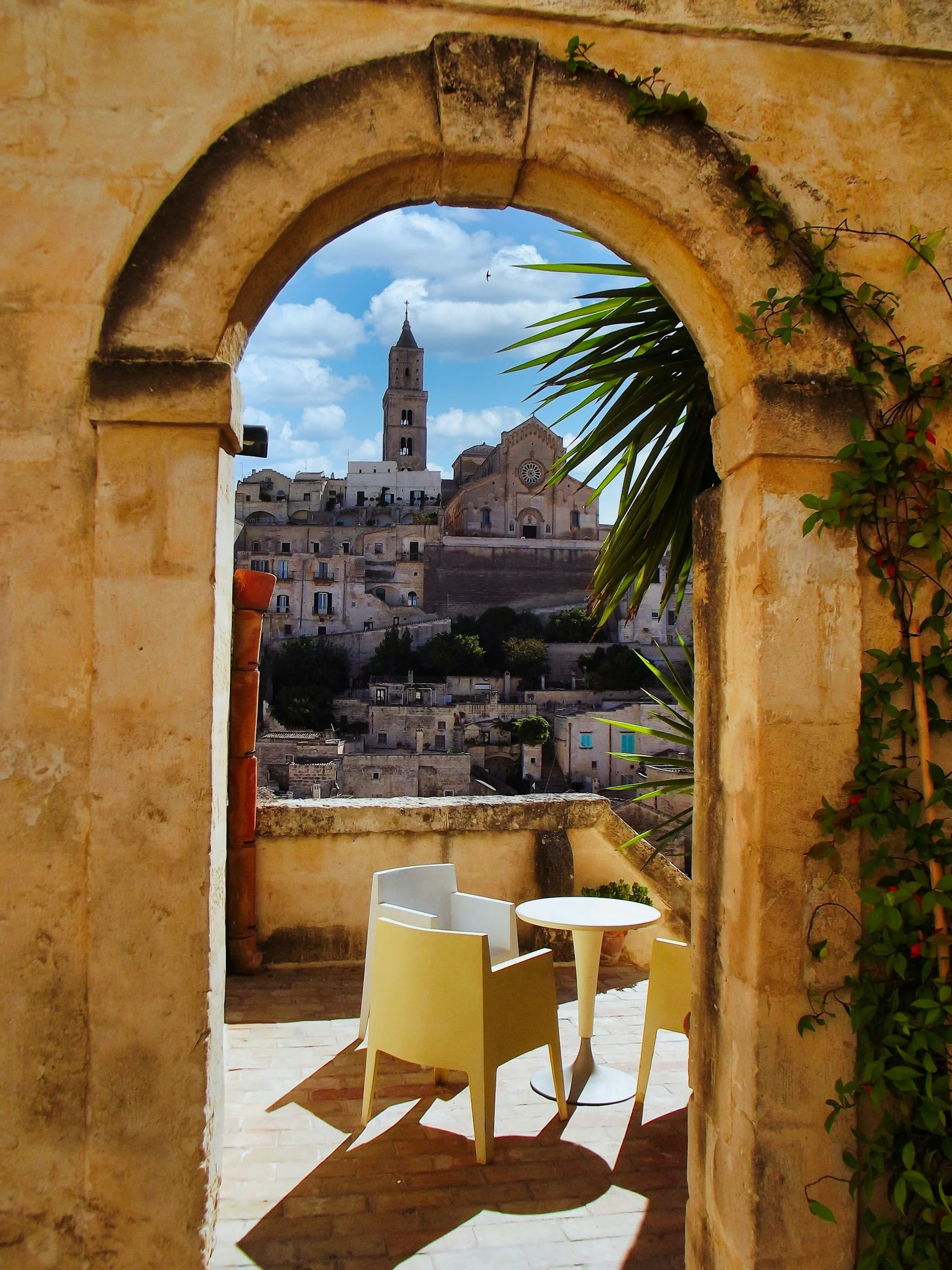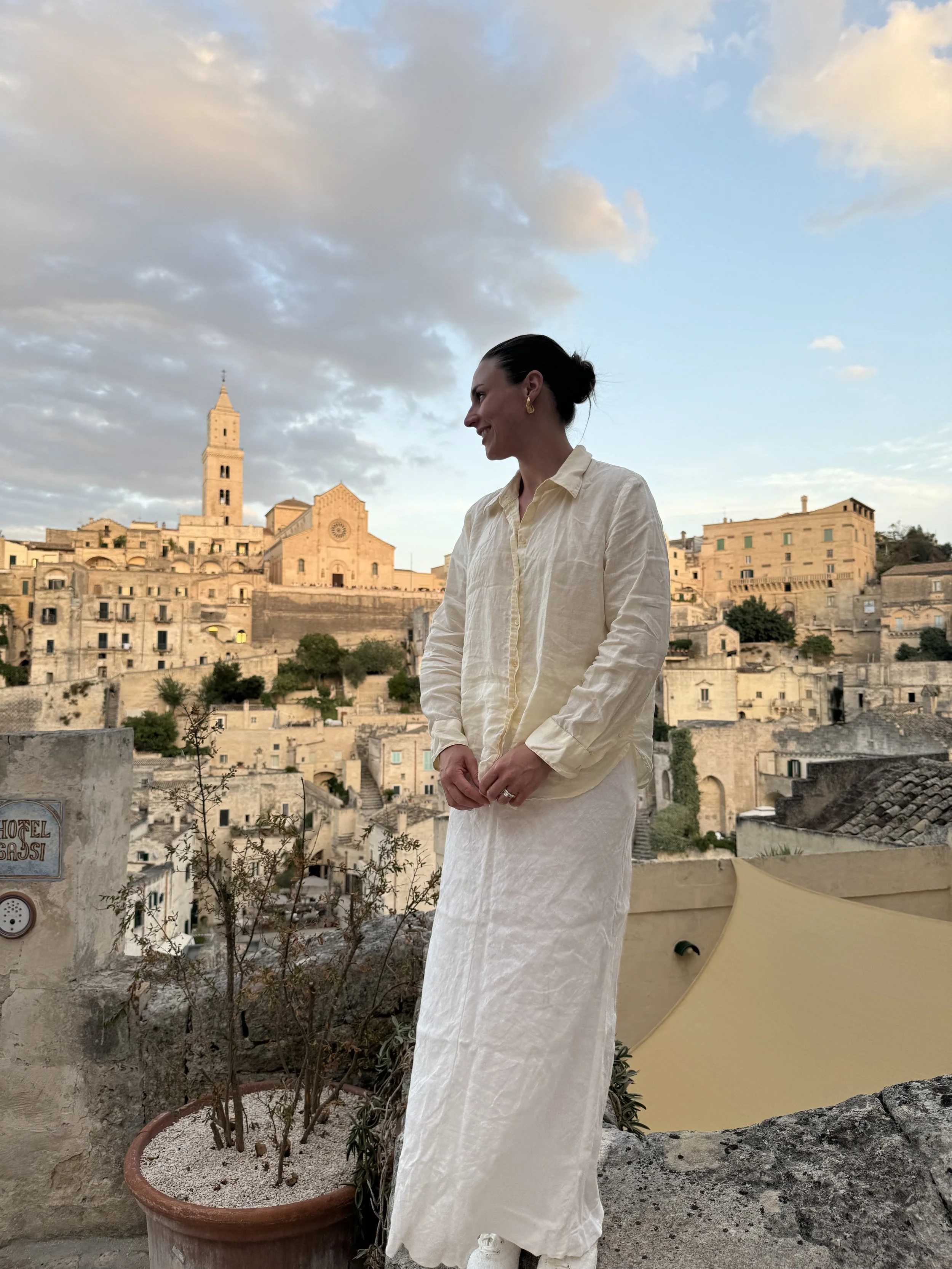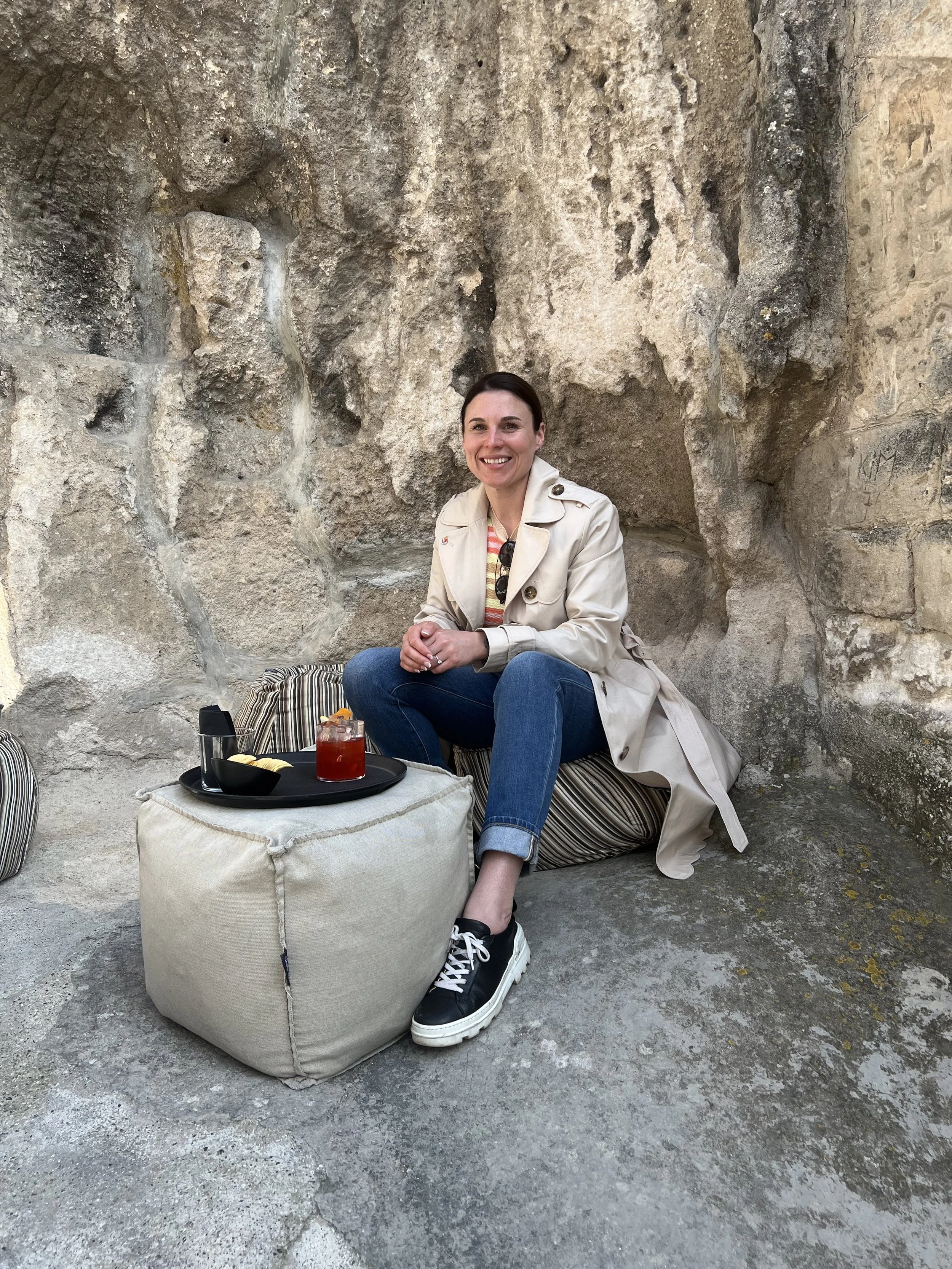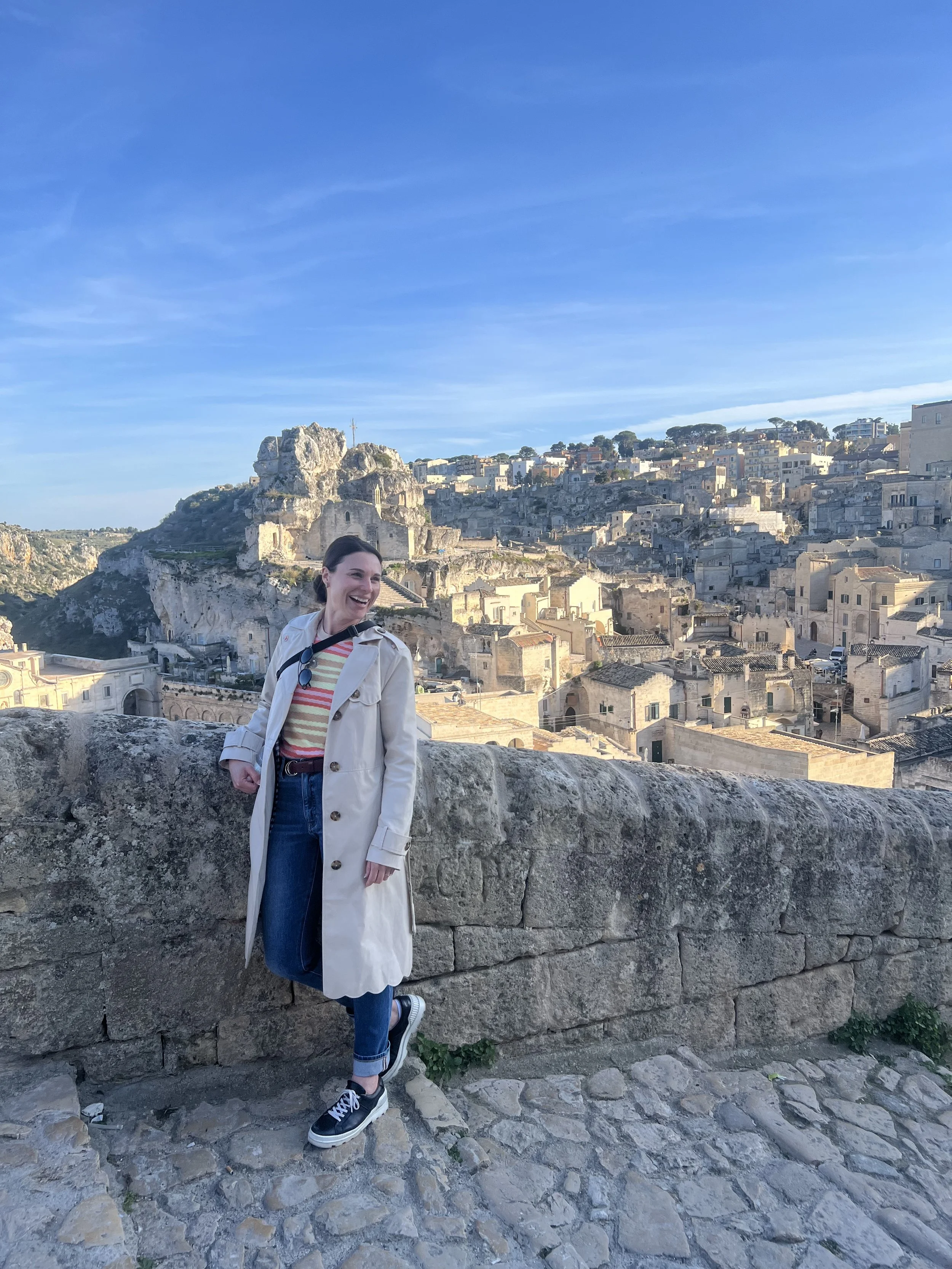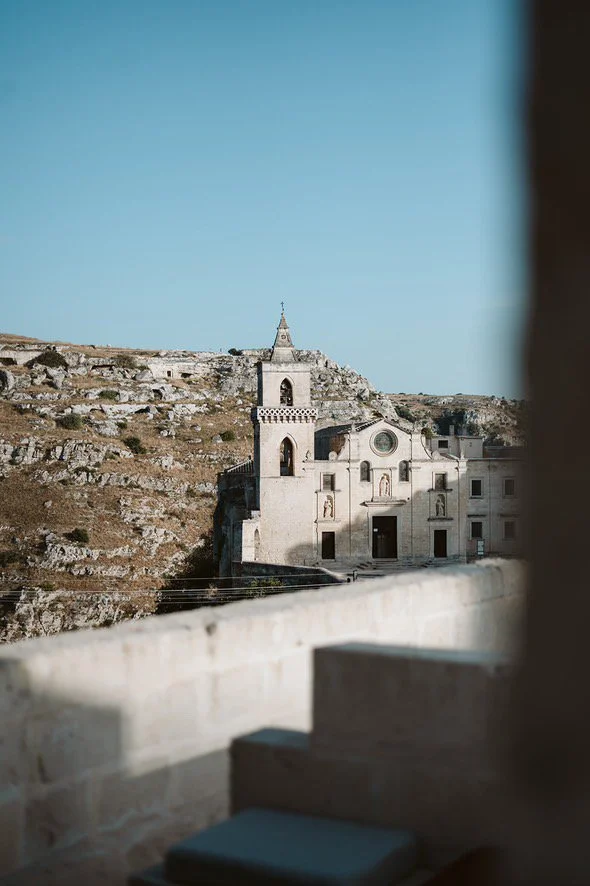Puglia Day 4: Matera
Ancient Caves & Liquid Gold
From the coast, make your way inland to Matera, a place so ancient and cinematic it could only exist in southern Italy. The journey from Monopoli is a scenic 77-kilometer drive that takes about 1 hour and 30 minutes, winding through the undulating countryside of Basilicata (not Puglia, as many assume—Matera sits just across the regional border). As you approach the town center along those serpentine roads that curl upward like ribbons, you'll catch your first glimpse of the honeyed limestone that has sheltered humanity for millennia.
Park in the upper town near Piazza Vittorio Veneto—trust me on this one. Matera is very much a "walking city," and you'll want to save your energy for the labyrinthine descent into one of the most stable and ancient human settlements in the world, with a history dating back over 9,000 years. When my parents visited after our wedding, they discovered this the hard way, lugging their many suitcases up and down what felt like kilometers of steps through an endless maze of stone passages to reach their hotel. It all makes perfect sense now why every hotel in Matera has a bar and offers a welcome drink upon arrival—because trust me, after navigating those ancient labyrinths with luggage, you'll absolutely need it!
Starting Underground: The Palombaro Lungo
My first encounter with Matera began beneath the surface at the Palombaro Lungo, the town's magnificent underground water cistern built in 1864 and known as "The Water Cathedral." This impressive feat of engineering carved into the rock beneath the main square was where I met Cosimo, a local guide who has been sharing Matera's secrets with visitors for years. When I mentioned that my parents would be traveling all the way from Australia to visit after our wedding, his eyes lit up. "Tell them to find me," he said with the kind of warmth that makes Italian hospitality legendary and so of course, I couldn’t resist but tell my parents.
Six months later, true to his word, Cosimo gave my parents an off-the-beaten-path experience that they still talk about today. While I was already making my way to Rome by car, they were discovering hidden corners of Matera that most tourists never see, guided by someone who truly understands every stone and story of this ancient place. It's these unexpected human connections that transform a destination from merely spectacular to genuinely unforgettable and remind us of the beauty of travel and wandering off the well trodden trails!
A Living Archaeological Marvel
The Sassi—literally translates to "stones"—aren't just tourist attractions; they're houses dug into the calcarenitic rock itself, with evidence that people were living here as early as the year 7000 BC. Walking through these districts feels like stepping through a portal where the most outstanding, intact example of a troglodyte settlement in the Mediterranean region unfolds before your eyes. Truly inspiring. Truly a ‘truthbumps’ momento.
Surprsingly, what strikes you first isn't the age of the place—though the Sassi of Matera are considered the oldest urban settlement in Europe—but how organically it all flows together. Cave churches carved by Byzantine monks sit beside homes that have been continuously inhabited for centuries, their facades blending seamlessly with the natural rock formations. The limestone here isn't just a building material; it's a living canvas that has been shaped by countless hands across countless generations. See, there’s some weight to the concept that the old is wise and well, the wise is old.
Where to Sleep: Inside The Stone
Stay at Sassi Hotel, where you can open shutters at dawn break and watch morning light pour over the honeycomb of cave dwellings like liquid gold. The room we stayed in had the most adorable swirling staircase that ushered you to your own private balconette. It did not matter whether in the lounge, bedroom or balconette, the views were mind- blowing. If time and finances allow, Matera offers several other extraordinary cave accommodations that take underground hospitality to an art form:
Le Grotte della Civita operates as an "albergo diffuso" - a scattered hotel where each room is a different cave dwelling connected by ancient pathways. It's like staying in your own private archaeological site, with rooms that feel more like elegant caverns than hotel accommodations.
Aquatio Cave Luxury Hotel & SPA brings five-star luxury to ancient rock, with sleek, minimalist rooms carved into rock with bright windows and those iconic white-washed walls. Opened in 2018 in the center of the Sassi, this UNESCO heritage location offers the perfect blend of contemporary comfort and troglodyte charm.
For something truly special, Sant'Angelo Matera features an authentic hideaway with a destination restaurant and underground pizzeria - because apparently even dining needs to happen inside the rock in Matera - and I mean, why not!
There's something almost mystical about waking up inside the rock itself, surrounded by the same limestone walls that have sheltered families since before the Roman Empire. These hotels manage to blend modern luxury with ancient architecture so seamlessly that you'll forget you're essentially living in a cave—until you step onto your terrace and see the entire sassi district spread out below you like an open-air museum.
Cocktails Carved From Time
At Zipa Café, cocktails are served from within the rock itself—it's as though time folded inwards and gave you a bar. The venue occupies what was once a cistern, carved deep into the limestone to collect precious rainwater. Now it collects something equally precious: travelers who've discovered that the best Negronis in southern Italy come with views that have been literally carved straight out of the past.
The bar's stone walls still bear the chisel marks of centuries-old craftsmen, and as you sip your aperitivo, you're drinking in the same space where medieval families once stored their most vital resource. The irony isn't lost on anyone—what once preserved life-sustaining water now serves life-enhancing spirits, both liquid and metaphorical.
Preparing for the Plunge
Don't forget your sneakers—there are more steps and labyrinths here than in Fes' Medina. The Sassi districts of Sasso Caveoso and Sasso Barisano are connected by a network of stairways, narrow passages, and hidden courtyards that can turn a simple walk into an archaeological adventure. Every corner reveals another layer of history, whether it's a Byzantine fresco peeking out from a cave church or a perfectly preserved rainwater collection system that's been feeding the community for a thousand years.
The beauty of Matera lies not just in its individual sights but in how the entire city functions as a living museum. The property shows evidence of continuous human occupation through several millennia until the present day, and is harmoniously integrated into the natural terrain and ecosystem. This isn't a place that was abandoned and restored for tourists; it's a place where life has flowed uninterrupted from the Paleolithic to the present.
Beyond the Instagram Shot
While Matera has certainly gained fame through films like "The Passion of the Christ" and "No Time to Die," what makes it truly special isn't its cinematic appeal—it's the realization that you're walking through humanity's longest-running neighborhood. People in Matera lived in the city of caves alongside their animals, often as large families without running water, sewers or electricity as late as the 1950s.
The transformation from ancient civilization to slum to hidden gem happened remarkably quickly. In 1993, UNESCO listed the Sassi as a World Heritage site, and now people have started moving back into the sassi, breathing new life into this old, historic place.
A Day Trip That Changes Your Perspective
As a day trip from Monopoli, Matera offers something that beachside Puglia cannot: a profound sense of continuity with the deep past. You'll return to the coast with limestone dust on your shoes and the understanding that humanity's story isn't just about progress and innovation—it's also about adaptation, persistence, and the remarkable ability to create beauty from the most challenging circumstances.
The drive back to Monopoli as the sun sets behind you feels different somehow. You've spent the day not just in another town, but in another era entirely, one where the line between natural and human-made has been blurred beyond recognition. And that golden light you watched pour over the sassi at dawn? It's the same light that has illuminated this settlement for nine thousand unbroken years.
Key Takeaways & Travel Tips:
Getting There: 77km from Monopoli (1.5-hour scenic drive through Basilicata countryside)
Where to Park: Upper town near Piazza Vittorio Veneto—Matera is a walking city. Pack those Nike’s!
Must-Stay: Sassi Hotel for the ultimate cave-dwelling experience with modern luxury at an affordable price, and a fabulous breakfast.
Essential Stop: Zipa Café for cocktails served from within ancient rock cisterns
What to Wear: Comfortable sneakers—the sassi districts are full of steps and narrow passages. Don’t forget a hat, water bottle and pack a sense of curiosity - you will be deeply inspired!
Best Time to Visit: Dawn for golden light photography, late afternoon for aperitivo with views, Dusk for romantic moments and postcard pictures worth writing home about.
Key Insight: This isn't just some other old place in Europe—it's continuously inhabited since 7000 BC, making it one of the world's oldest living cities. Make the trip, it’s worth it.
Don't Miss: The realization that you're walking through 9,000 years of uninterrupted human history, carved directly into the living rock - oh, and that negroni at Zipa Cafe? That’s a must on the to do list.
And if you’d like to explore which part of Puglia is calling your name—checkout my Complete Guide here.


